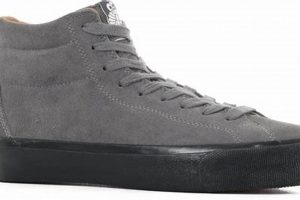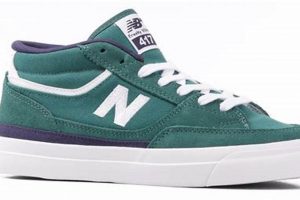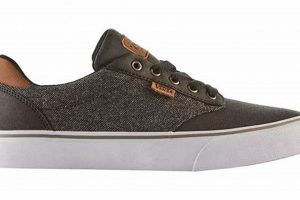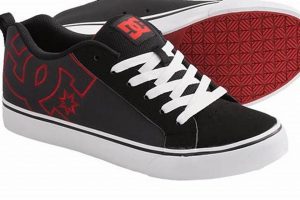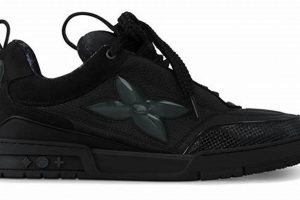The correlation between footwear dimensions and skating boot measurements presents a crucial consideration for prospective skaters. Footwear size typically refers to the internal length of a standard shoe, whereas skating boot dimensions are often calibrated differently to account for the rigid structure and performance requirements of the sport. For example, an individual who wears a size 10 shoe may find that a size 9.5 or even 9 skating boot offers a more suitable fit.
Accurate assessment of skating boot dimensions is paramount for comfort, performance, and safety. A properly fitted skating boot enhances control and responsiveness, preventing injury and maximizing the skater’s potential. Historically, variations in sizing standards across manufacturers have complicated the selection process, necessitating careful measurement and consideration of specific brand guidelines. These variations underscore the need for specialized guidance in determining appropriate skating boot dimensions.
The subsequent sections will provide detailed information on methods for accurately measuring foot size for skating boots, explore common sizing discrepancies among different skating disciplines and brands, and offer strategies for achieving an optimal fit. This guidance aims to clarify the nuances of selecting appropriately sized skating boots and mitigating potential fitting issues.
Guidance on Determining Appropriate Skating Boot Dimensions
The following recommendations serve as a guide to assist in selecting appropriately sized skating boots. Adherence to these principles can minimize fitting errors and enhance the skating experience.
Tip 1: Measure Foot Length Accurately: Employ a Brannock device or a similar measuring tool to determine the precise length of both feet. Account for any discrepancies between the two measurements, using the larger foot as the basis for sizing.
Tip 2: Consult Brand-Specific Sizing Charts: Manufacturers often employ unique sizing conventions. Refer to the specific sizing chart provided by the skating boot manufacturer to correlate foot length with the corresponding boot size.
Tip 3: Consider the Intended Use: Different skating disciplines, such as ice hockey, figure skating, or roller derby, may require varying degrees of snugness or room within the boot. Account for this when selecting a size.
Tip 4: Prioritize a Snug Heel Fit: The heel should be securely held within the boot to prevent slippage. Excessive heel movement can lead to discomfort, blisters, and diminished control.
Tip 5: Assess Toe Clearance: While a snug fit is desirable, ensure sufficient toe clearance to prevent cramping or pressure points. A thumb’s width of space between the longest toe and the end of the boot is generally recommended.
Tip 6: Account for Sock Thickness: The type of sock worn during skating should be considered when determining boot size. Thicker socks may necessitate a slightly larger boot size.
Tip 7: Seek Professional Assistance: Consult with a knowledgeable skate fitter for personalized guidance. An experienced fitter can assess foot morphology and provide recommendations tailored to individual needs.
By carefully considering these factors, individuals can improve the likelihood of selecting appropriately sized skating boots, enhancing comfort, performance, and safety on the ice or roller surface.
The subsequent section will address potential fitting issues and provide strategies for resolving common problems encountered during the skating boot selection process.
1. Measurement discrepancies
Measurement discrepancies form a fundamental aspect of the challenges encountered when determining the correct skate size relative to shoe size. The disparity arises from the distinct construction and intended function of each type of footwear. Standard shoes are designed with a degree of flexibility and accommodate a certain amount of foot movement within the shoe. In contrast, skating boots prioritize rigid support and control, often requiring a closer, more precise fit. This difference necessitates specialized measurement approaches and complicates direct size comparisons. For instance, a skater who wears a size 9 shoe may require a size 8.5 or even 8 skate, depending on the brand and model, due to these dimensional differences.
The impact of measurement discrepancies extends beyond mere convenience, directly influencing performance and injury risk. An ill-fitting skate can lead to blisters, pressure points, and impaired balance, increasing the likelihood of falls and ankle injuries. Furthermore, improper fit diminishes the skater’s ability to effectively transmit power and control to the skates, hindering performance in activities ranging from recreational skating to competitive sports. Real-world examples abound: skaters attributing ankle pain or numbness to “breaking in” new skates, only to discover that the skates were improperly sized from the outset. This underscores the necessity of accurate foot measurement and consultation with knowledgeable skate fitters to mitigate the risks associated with dimensional inconsistencies.
In conclusion, the inherent measurement discrepancies between shoe size and skate size necessitate careful attention to detail during the skate selection process. Ignoring these differences can lead to discomfort, impaired performance, and increased risk of injury. A thorough understanding of these discrepancies, combined with accurate foot measurement and expert guidance, is crucial for ensuring a proper and safe skate fit, aligning with the broader theme of informed skate equipment selection and promoting optimal skating experiences.
2. Brand variations
Brand variations significantly impact the assessment of appropriate skate size relative to shoe size. Each manufacturer employs distinct sizing algorithms, resulting in considerable discrepancies even when comparing products intended for the same skating discipline. These variations stem from differing design philosophies, manufacturing tolerances, and target customer demographics. Consequently, an individual with a consistent shoe size may experience a range of skate sizes across various brands. For example, a size 8 shoe wearer might find that a size 7 skate fits best from one manufacturer, while a size 7.5 is optimal from another. This inconsistency necessitates careful consideration of brand-specific sizing charts and, ideally, in-person fitting.
The effect of brand variations extends beyond mere inconvenience. The rigid structure of skating boots leaves little room for error in sizing. A skate that is even slightly too small or too large can lead to discomfort, blisters, and impaired performance. Furthermore, ill-fitting skates can increase the risk of injuries, particularly ankle sprains, due to reduced support and control. Consider the competitive skater who switches brands; they must undergo a complete refitting process, accounting for subtle differences in boot shape and internal dimensions. The practical significance lies in the need for thorough research, including consulting online resources and seeking advice from experienced skate fitters, before committing to a purchase. Ignoring brand variations can result in a costly mistake and a suboptimal skating experience.
In conclusion, brand variations represent a critical factor in determining the correct skate size relative to shoe size. These inconsistencies highlight the limitations of relying solely on shoe size as a point of reference. Skaters must prioritize brand-specific sizing information and, whenever possible, seek professional fitting assistance to ensure optimal comfort, performance, and safety. A failure to acknowledge brand variations can lead to discomfort, diminished performance, and increased injury risk, underscoring the importance of diligent research and informed decision-making throughout the skate selection process.
3. Discipline specificity
Discipline specificity exerts a considerable influence on the relationship between skating boot dimensions and standard footwear dimensions. Different skating disciplines, such as ice hockey, figure skating, recreational skating, and roller derby, necessitate distinct boot designs and fitting characteristics. Ice hockey skates, for instance, prioritize agility and responsiveness, often requiring a snug fit that may correspond to a smaller size than the skater’s conventional shoe size. Conversely, recreational skates may offer a more relaxed fit, potentially aligning more closely with standard shoe sizes. Figure skating boots demand exceptional ankle support and precise control, often necessitating a specialized fitting process that takes into account the skater’s skill level and blade mounting position. Roller derby skates, with their low-cut design and emphasis on maneuverability, present yet another set of sizing considerations.
The implications of discipline-specific sizing extend beyond mere comfort. In ice hockey, a properly fitted skate enhances a player’s ability to accelerate, turn sharply, and maintain balance, directly impacting on-ice performance. In figure skating, a secure and supportive boot is essential for executing complex jumps and spins with precision and minimizing the risk of ankle injuries. Recreational skaters may prioritize comfort and ease of use, opting for a slightly more forgiving fit, while roller derby players require skates that provide both agility and protection during high-impact maneuvers. The selection of an inappropriately sized skate, even by a seemingly small margin, can compromise performance, increase the risk of injury, and detract from the overall skating experience. This underscores the need for skaters to consult with experienced skate fitters who possess expertise in the specific discipline of interest.
In conclusion, discipline specificity is an indispensable consideration in the determination of appropriate skating boot dimensions relative to shoe size. The unique demands of each skating discipline necessitate tailored boot designs and fitting characteristics. Ignoring these discipline-specific nuances can lead to suboptimal performance, increased injury risk, and a diminished skating experience. A thorough understanding of these factors, combined with expert fitting advice, is essential for ensuring a secure, comfortable, and performance-enhancing skate fit, emphasizing the practical significance of discipline-aware skate selection.
4. Fit importance
The appropriate fit of skating boots is paramount, directly influencing performance, comfort, and safety. A thorough understanding of dimensional variance relative to standard shoe size is therefore indispensable for all skaters, regardless of skill level or discipline.
- Performance Optimization
A precisely fitted skating boot maximizes energy transfer and control. An overly large boot inhibits efficient power transmission, while an excessively small boot restricts foot movement and circulation. For competitive skaters, even minor discrepancies in fit can measurably degrade performance, affecting speed, agility, and execution of technical maneuvers. Real-world examples include hockey players experiencing delayed response times due to boot slippage and figure skaters struggling with jump landings due to inadequate ankle support, both directly attributable to improper fit.
- Injury Prevention
Ill-fitting skating boots significantly elevate the risk of injury. Boots that are too large can lead to ankle instability and an increased likelihood of sprains. Boots that are too tight can cause blisters, pressure sores, and nerve compression. Furthermore, chronic misalignment resulting from an improper fit can contribute to long-term musculoskeletal problems, such as plantar fasciitis and Achilles tendinitis. Emergency room visits attributed to skate-related injuries frequently involve issues stemming from inadequate fit, highlighting the critical need for careful sizing and professional fitting assistance.
- Comfort and Enjoyment
Comfort directly impacts the skating experience. Discomfort caused by ill-fitting boots can distract the skater, diminish focus, and ultimately detract from enjoyment. Prolonged skating in poorly fitted boots can lead to foot fatigue, pain, and even permanent deformities. Recreational skaters, in particular, may be discouraged from pursuing the activity if they experience persistent discomfort, underscoring the importance of prioritizing a comfortable and supportive fit from the outset.
- Longevity of Equipment
A properly fitted skate boot will maintain its structural integrity longer than one subject to undue stress from an improper fit. Skates that are too large experience accelerated wear as the foot moves excessively within the boot, stressing the seams and materials. Skates that are too small can deform under the constant pressure of the foot, reducing their lifespan and potentially compromising their safety features. Investing in a correctly fitted skate not only benefits the skater but also extends the functional lifespan of the equipment.
These facets collectively underscore the critical connection between fit importance and the complexities of navigating dimensional differences relative to shoe size. Regardless of skating discipline or skill level, prioritizing a precise and comfortable fit is essential for optimizing performance, preventing injuries, enhancing enjoyment, and maximizing the longevity of skating equipment. The nuances of skate dimensions, as compared to shoe dimensions, further emphasize the need for informed decision-making and professional consultation to ensure a positive and safe skating experience.
5. Conversion complexities
Dimensional translation between standard shoe measurements and skate sizing introduces notable complexities, stemming from non-uniform sizing standards and discipline-specific requirements. The primary cause lies in the inherent functional differences between shoes and skates. Shoes prioritize comfort and general mobility, while skates emphasize support, control, and energy transfer. Consequently, skate sizing often deviates significantly from shoe sizing. An individual expecting a direct size equivalence may encounter considerable discrepancies across different skate brands and disciplines. The importance of acknowledging these complexities is paramount; failure to do so can lead to ill-fitting skates, resulting in discomfort, diminished performance, and an elevated risk of injury. A recreational skater, for instance, purchasing skates solely based on shoe size may find the skates too large, compromising stability and control.
Further complicating the dimensional translation is the variability in sizing conventions across manufacturers. Each brand often employs proprietary sizing algorithms, considering factors such as foot width, instep height, and ankle circumference. This necessitates consulting brand-specific sizing charts and seeking professional fitting assistance. The practical significance of understanding these intricacies lies in the ability to make informed purchasing decisions. A hockey player, for example, needs to consider not only foot length but also the desired level of boot stiffness and ankle support, requiring a more nuanced approach to sizing than simply relying on a shoe size conversion. Additionally, different skating disciplines (e.g., figure skating, roller derby) demand specific boot characteristics, further complicating the sizing process.
In summary, dimensional translation between shoe sizes and skate sizes involves inherent complexities stemming from functional differences, manufacturer variations, and discipline-specific requirements. Acknowledging these complexities is crucial for ensuring a proper skate fit, optimizing performance, and minimizing the risk of injury. Skaters should prioritize consulting brand-specific sizing charts and seeking guidance from experienced fitters to navigate these intricacies and make informed purchasing decisions. Ignoring these dimensional translation challenges can lead to discomfort, impaired performance, and a potentially unsafe skating experience.
Frequently Asked Questions
The following questions address common concerns and misconceptions surrounding the dimensional relationship between shoe and skate sizes.
Question 1: Is skate sizing directly equivalent to shoe sizing?
No, a direct equivalence between shoe and skate sizing cannot be assumed. Skate sizing often differs significantly from shoe sizing due to the specialized construction and intended function of skating boots.
Question 2: Why does skate sizing differ from shoe sizing?
The primary reason for the difference lies in the distinct performance requirements of skating. Skates demand a snug, supportive fit for optimal control and energy transfer, while shoes typically prioritize comfort and a more relaxed fit.
Question 3: How does brand variation affect skate sizing?
Brand-specific sizing algorithms introduce inconsistencies in skate sizing. Each manufacturer employs unique dimensional standards, necessitating consultation of brand-specific sizing charts prior to purchase.
Question 4: Does the skating discipline influence skate sizing?
Yes, different skating disciplines (e.g., ice hockey, figure skating, roller derby) require distinct boot characteristics and fitting profiles, impacting the appropriate skate size for a given individual.
Question 5: What happens if skates do not fit properly?
Improperly fitted skates can lead to discomfort, blisters, impaired performance, and an elevated risk of injuries, such as ankle sprains and stress fractures.
Question 6: Is professional fitting assistance recommended?
Yes, professional skate fitting is strongly recommended. Experienced fitters can assess foot morphology, consider skating discipline, and provide tailored recommendations to ensure optimal comfort, performance, and safety.
Proper skate sizing is critical for ensuring a safe and enjoyable skating experience. It is recommended to prioritize brand-specific sizing charts and professional assistance when determining the appropriate skate size.
The subsequent section will outline specific strategies for accurately measuring foot size and selecting appropriately sized skating boots.
Conclusion
This exposition has detailed the critical distinctions between “skate size vs shoe size,” emphasizing the nuances arising from disparate sizing conventions, brand variations, and discipline-specific requirements. Accurate skate sizing directly impacts performance, comfort, and safety, necessitating careful measurement and consultation with professional fitters. A superficial adherence to shoe size as a benchmark for skate sizing can lead to suboptimal outcomes, potentially resulting in discomfort, diminished performance, and elevated injury risk.
The complexities inherent in the “skate size vs shoe size” equation demand a discerning approach. Skaters are strongly encouraged to prioritize professional fitting services and brand-specific sizing charts to ensure the optimal selection of skating equipment. This investment in proper fit will yield tangible benefits in terms of enhanced performance, injury prevention, and a more rewarding skating experience. Continued awareness of these dimensional discrepancies is crucial for promoting safe and effective participation in all skating disciplines.


